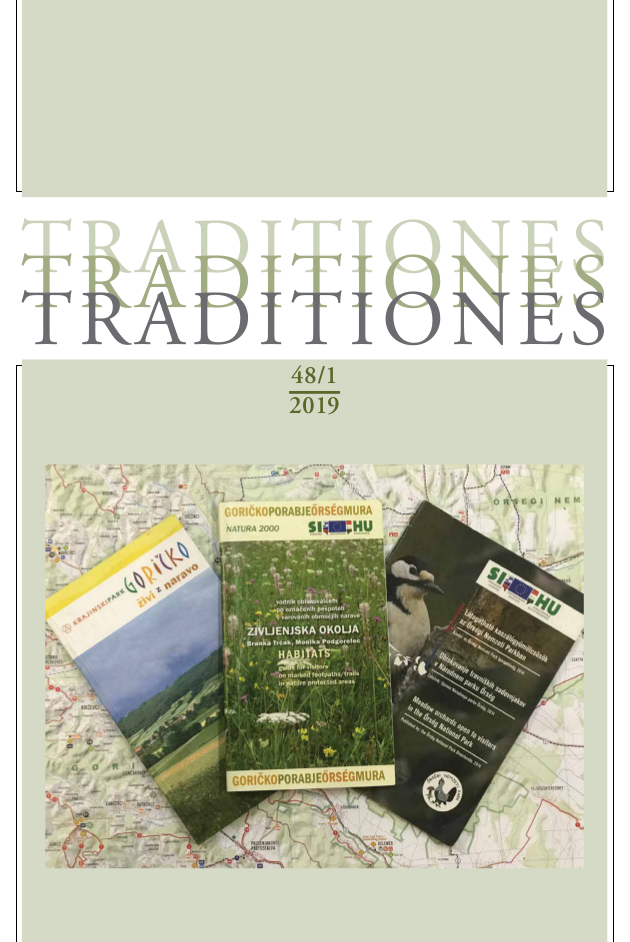“Meja, ki deli in povezuje”
Spomeniki in komemoracije na slovensko-madžarski meji
DOI:
https://doi.org/10.3986/Traditio2019480104Ključne besede:
slovensko-madžarska meja, spomeniki, spominska mestaPovzetek
Avtor v razpravi analizira postopek postavljanja spominskih znamenitosti in spomenikov na slovensko-madžarski meji ter temeljne namene in motive. Po postavitvi obmejne skupnosti še naprej uporabljajo nekatere spomenike, kjer redno prirejajo komemoracije.
Prenosi
Literatura
Assman, Jan. 2011. Cultural Memory and Early Civilization: Writing, Remembrance, and Political Imagination. Cambridge: Cambridge University Press.
Borsos, Balázs. 2017. The Regional Structure of Hungarian Folk Culture. Münster: Waxmann.
Dömötör, Sándor. 1960. Őrség. Budapest: Gondolat Kiadó.
Gráfik, Imre. 2013. Határtalanul: Határon innen és túl. Pécs: Pro Pannónia Kiadói Alapítvány.
Halász, Albert. 1998. Hetés és Lendvavidék kapcsolatai. Muratáj 1: 143–153.
Halász, Albert. 1999. Jeles napok, népi ünnepek a Muravidéken. Lendava: Magyar Nemzetiségi Művelődési Intézet.
Halbwachs, Maurice. 1992 (1950). On Collective Memory. Chicago: University of Chicago Press.
Harlov-Csortán, Melinda. 2017. From the Borderland of the Iron Curtain to European and World Cultural Heritage. Folklore 70: 193–224. DOI: https://doi.org/10.7592/FEJF2017.70.harlov_csortan
Ilyés, Zoltán. 2010. Etnicitás és szimbolikus geográfia: A táj kisajátítása, különösen határvidékek, kontaktzónák esetén. In: Margit Feischmidt (ed.), Etnicitás: Különbségteremtő társadalom. Budapest: Gondolat – MTA Kisebbségkutató Intézet, 114–125.
Lendvai Kepe, Zoltán. 2005. Az uniós csatlakozás a muravidéki magyarok és szlovénok között. In: Zoltán Klamár (ed.), Etnikai kontaktzónák a Kárpát-medencében a 20. század második felében. Aszód: A Pest Megyei Múzeumok Igazgatósága, 215–226.
Lendvai Kepe, Zoltán. 2007. Boldogulás Hetésben: Hetés falvai a történelem, a néprajz és az ökológiai antropológia tükrében. Lendava: Magyar Nemzetiségi Művelődési Intézet.
Mohos, Mária. 2008. A Rábától a Muráig: A magyar-szlovén határtérség történeti-földrajzi vizsgálata. Szombathely: Nyugat-magyarországi Egyetem Savaria Egyetemi Központ Szláv Filológiai Intézet.
Nora, Pierre. 1989. Between Memory and History: Les Lieux de Mémoire. Representations 26: 7–24.
Turai, Tünde (ed.). 2015a. Hármas határok néprajzi értelmezésben. Budapest: MTA BTK Néprajztudományi Intézet.
Turai, Tünde. 2015b. Határjárók és határ mellett élők: Hármas-határ helyzet Magyarország délnyugati, délkeleti és északkeleti térségében. In: Tünde Turai and Csaba Mészáros (eds.), Hármas határok néprajzi nézetben. Budapest: MTA BTK Néprajztudományi Intézet, 7–17.
Vedó, Attila. 2009. Magyarország államhatárának megjelölése 1947-től napjainkig. Rendvédelmi-történeti Füzetek 16 (19): 137–149.
Zhurzhenko, Tatiana. 2011. Borders and Memory. In: Doris Waste-Walter (ed.), The Ashgate Research Companion to Border Studies. Farnham, UK: Ashgate 63–84.
Zsiga, Tibor. 1999. “A vasfüggöny és kora”: Der Eiserne Vorhang und seine Zeit. Budapest: Hanns Seidel Alapítvány.
Prenosi
Objavljeno
Kako citirati
Številka
Rubrike
Licenca
Avtorji jamčijo, da je delo njihova avtorska stvaritev, da v njem niso kršene avtorske pravice tretjih oseb ali kake druge pravice. V primeru zahtevkov tretjih oseb se avtorji zavezujejo, da bodo varovali interese založnika ter da bodo povrnili morebitno škodo.
Podrobneje v rubriki: Prispevki






